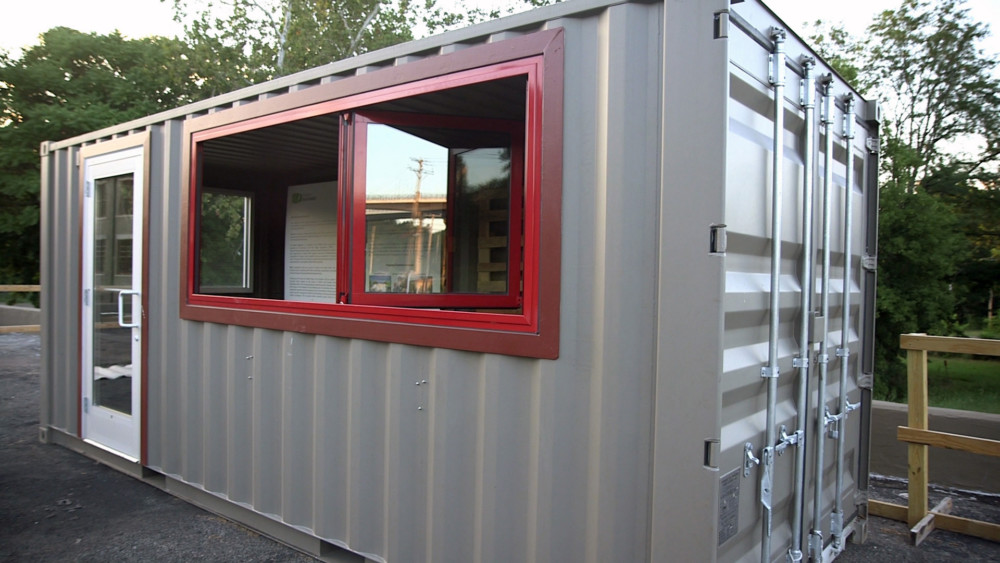By Doug Livingston
The Akron Beacon Journal
WWR Article Summary (tl;dr) At the “Akron Soul Train”, Artists will produce art while living and working in 40-by-10 steel containers more commonly seen on railways and cargo ships. One-month stipends are being offered for three artists to move in this summer.
The Akron Beacon Journal
The first of many transient artists could move into shipping containers in a wooded lot near downtown Akron this summer.
Akron Soul Train, a proposed village of tiny homes for traveling artists, is moving full-steam ahead. The project secured $150,000 from the Knight Arts Challenge last year.
“We’re being watched nationally because we were given the largest Knight grant in the nation,” said Amy Mothersbaugh of Studio 2091, who co-founded Akron Soul Train with Nancy Brennan of Kasota Artist Management.
The plan is to clear brush from a lot on the northwest corner of Howard and Beach streets.
Artists will produce art in the public space while living and working in 40-by-10 steel containers more commonly seen on railways and cargo ships. One-month stipends are being offered for three artists to move in this summer.
“Everyone is asking, ‘Can they do it?'” said Mothersbaugh, who has learned so far not to think too small.
With the help of Akron Soul Train development director Danielle Thompson, the group has raised $120,000 in private funding to match the Knight grant.
On Monday, Akron City Council approved a rezoning request to allow four phases of construction, ultimately resulting in what could be a canopy-covered village of brightly colored containers with sculptors, painters and visual artists mingling with pedestrians.
The artists’ playground will anchor the past in a space between the Ohio & Erie Canal Towpath Trail and the Cuyahoga Valley Scenic Railroad, while building a bridge for future generations.
“It’s very central,” Mothersbaugh said of picking a location near a new hotel, bustling restaurants and an arts district taking root in the northwestern reaches of downtown. “We will connect parts of Akron that were disconnected before.”
Four phases
Mothersbaugh, Thompson and developer/designer Becky McAdams, vice president of operations for GPD Group, laid out a vision of four construction phases, which they hope will cost no more than $2.9 million.
Phase 1 begins in a few weeks. Two shipping containers, with the amenities of a typical apartment, will be designed to house traveling artists. A third container will be outfitted with enough toilets to accommodate everyone, including the public, when the project is fully completed in three or four years.
The containers can be purchased for $1,500 to $2,000. “You could by them online. You could buy them right now,” McAdams said.
Cleveland is loaded with used shipping containers looking for reuse, added Mothersbaugh. To turn them into tiny homes with drywall, plumbing and electrical wiring, another $18,000 will be pumped into each unit.
Their project draws inspiration from container parks erected across the nation as cities like Las Vegas, Tulsa and San Diego welcome the recycling of the industrial transportation blocks into public spaces for the arts and entertainment.
The Akron project also borrows from Pittsburgh’s Mattress Factory, which for 40 years has provided artists space to create.
Phase 2 brings another two residential shipping containers and another for office and retail use. Art created on site will be sold to sustain the project, which also plans for sustainable green infrastructure like rain-collecting roofs and permeable pavement. A concession container will round out the public space.
Phase 3 covers the village with a canvas canopy and upgrades to local parking lots, which will be touched up with gravel in the first round.
The fourth and final phase calls for a private developer to pitch a 6,000-square-foot, two-story building with maybe a coffee shop on the bottom and studio apartments on top.
From there, the sky’s the limit. Like a kid with a tub of Lego blocks, “we can always add more,” said Mothersbaugh. “We can go up and we can go out.”
The group’s plan is to turn the operation over to the city after the venture is self-sufficient, likely in about five years.
The rezoning received unanimous support from city council following a favorable recommendation by city planning and other departments that review traffic, crime, congestion, utilities and other issues.
The only concern came afterward as Councilwoman Veronica Sims asked the city keep an eye on the project to make sure that African-American history is represented in an area that was a hub for black entrepreneurs in the days of segregation.














































































































































































































































































































































































